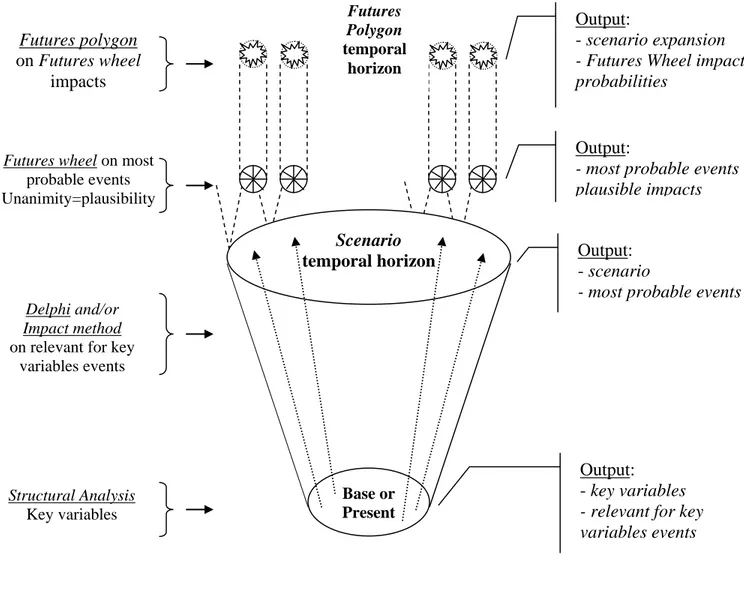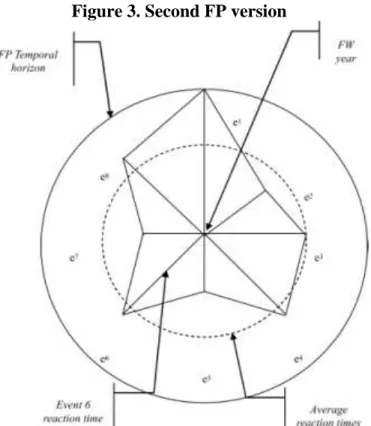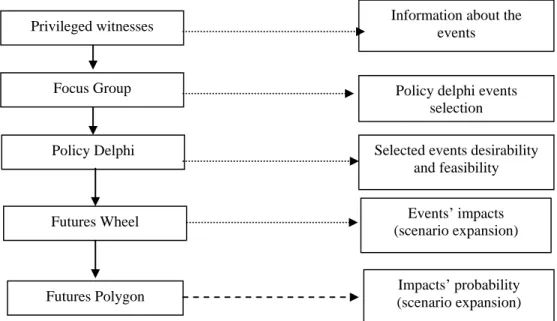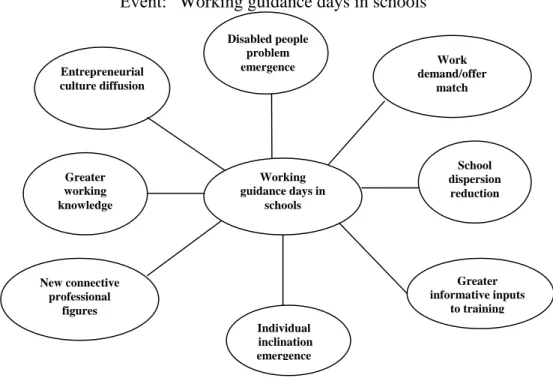T
HE
F
UTURES
P
OLYGON
by
Antonio Pacinelli
I. History of the Method
II. What is the Method
III. How to Do It
IV. Strengths and Weaknesses
V. Use in Combination with other Methods
VI. Speculation about the Future of the Method
Appendix: Examples of uses of the method
References
I.
H
ISTORY OF THEM
ETHODThe idea of the Futures Polygon (FP) stemmed from reading about the Futures Wheel (FW) in Futures Research Methodology 1.0 (Glenn, Gordon, 1994) and realizing that the Futures Wheel lacked the concept of evaluating the likelihood of forecasted impacts, an indispensable element in exploring the future, The FW creator regarded unanimity1 as a good indicator of the
plausibility of events/impacts on which there is agreement, because the unanimity can be interpreted as a “guarantee” that the impact will happen within a “realistic temporal horizon”. The plausibility judgment should precede any forecasting or scenario because if the event is not plausible it doesn’t fall within the “cone of plausibility” (someone defines it as a forecast cone), which is a fundamental instrument for surveys about the future. The previous observations stimulate some questions:
What is the probability that the plausible events have to happen within a certain temporal
horizon?
How many years does the system of interest require to register a first reaction to the impact?
How many years does the impact intensity require to get to its maximum? How long does the impact last? What is the impact consolidation level? (as in Gordon’s Trend Impact
Analyses – 1994).
Two complementary problem areas emerge from FW:
evaluation of the probability of an “impact scenario” generated by FW determination of a “realistic temporal horizon” for FW results
and two different FP versions originate from them. To give an answer to the previous questions, in fact, a first, complementary to FW, method was created with the capacity to give indications about the probability of the generated “impact scenario” (for each event and for the overall scenario), while a second version of that method was finalized to yield a realistic temporal horizon evaluation. The method is called Future Polygon (Pacinelli, 2006) because the different probabilities of the events/impacts obtained by FW and their own different years of occurrence generate a polygon if connected with a line.
1
The unanimity rule (Wagschal, 1981) is an important point of reference for people using participatory methods (Pacinelli, 2007) but it’s not sufficient to make a foresight, which needs an occurrence probability for each event/impact.
The Futures Polygon 2
II.
W
HAT IS THEM
ETHOD?
It is appropriate to precede the description of the FP method by some observations which are useful for locating it within the area of impact analysis. Methods for the study of event impacts can be assigned to at least three different areas:
consequential impact events when one or more events in a system happen: Event Impact; one or more events impact on a time series trend: Trend Impact;
impacts among several events: Cross-impact.
Event impact analysis treats consequential impacts arising from one occurring event, which can
be expected or unavoidable (as for some natural phenomena) or can derive from an intervention, political or other. It is possible to include the Futures Wheel (Glenn, 1972) and its derivative and complementary Futures Polygon method (Pacinelli, 2006) into this area. The Futures Polygon has recourse to the Delphi procedure in order to obtain probability evaluations of each futures “wheel” event and to transform them into a polygon. The Futures Polygon's aim is to graphically depict the occurrence probability of the whole set of events obtained by the Futures Wheel.
Trend impact analysis (Gordon, 1994) is designed to study the impact of possible future events
on the trend of the value of some quantitative or qualitative variable. The approach governing these methods consists of correcting the extrapolated trend of one or more phenomena, on the basis of subjective evaluations which are formulated by experts on the effects that a determined set of events may produce on that trend2. The TIA can be integrated by other forecasting methods based on models.
Cross impact analysis allows consideration of the mutual impacts of a set of events with each
other, generally collected into a matrix. Cross impact, based on the study of interactions among a set of events, is the richest of the methods each of which has its own goal, depending on the objective for which it was created: correcting the probabilities obtained by a Delphi (Dalkey-Helmer, 1963), tracing trajectories towards the future (Kane, 1972), or building scenarios (Brauers-Weber, 1988)3. Cross-impact can itself be classified as of three different types, on the basis of the approach used by the techniques which are part of it: a simulative approach, a
heuristic approach or an optimization approach4.
2
The evaluation can concern year of first impact, impact length, impact intensity, etc.
3
Particularly, Cross-impact simulates different decisions compared to different future situations, aiming to determine optimal and/or preferable strategies.
4
The majority of the methods in this area generate incoherent probabilities which are often not compatible with the classical theories of probability calculus. Explor-Sim, Smic and other methods try to get over this problem, even if none of them achieve completely satisfying success on it. Dalkey (1972) particularly suggests a method to verify the coherence of a set of considered events and, in case of a negative outcome, proposes a procedure to make them become so.
III.
H
OW TOD
OI
TFuture Polygon should be applied at the conclusion of the phases related to the scenario building activity and not after a single event impact evaluation. The principal characteristic of “event impact” methods, as for example Futures Wheel and its derivatives, is to build the scenario expansion from the events considered in it. In other words, each of the events which constitute a scenario can activate elements in its turn which render the happening of other events most probable. The application of event impact, with a set of n events constituting the scenario, generates for each of them an expansion of the scenario itself because other primary order impacts, deriving from the previous ones, are added in and the expansion can increase again if we also consider the second order impacts. The process is the following:
First of all, the “wheel of futures”, obtained by the Futures Wheel, is adopted; the application of the “rule of unanimity” for the plausibility evaluation of impacts has eliminated events on which there is no agreement among participants, so that work continues only on impacts which are considered as plausible. The requirement to work only on plausible events is really important because it excludes situations in which some experts could value impossible (or nearly) impacts;
When the Futures Wheel result is ready, each Futures Wheel participant (or a new participant panel) is asked to attribute an occurrence probability to recognized impacts, following the well known Delphi procedure (Dalkey-Helmer, 1963). The group could in fact agree, during face to face discussion, on single probabilities (or intervals) to be assigned to impacts, or subjective evaluations can be reinforced by structured
communication procedures, as, for example, the Delphi method. The question, addressed by the mediator-facilitator to the group, will be formulated as following: “What
probability do you attribute to the occurrence of each plausible event deriving from the Futures Wheel within the [time period]______?”;
When the occurrence probability evaluation within the settled date has been done for all Futures Wheel impacts for a particular event, the graphic representation is constructed, using a somewhat polar system of reference. An O point, called the “pole”, is fixed on the plane (it corresponds, in this case, to the event whose future implications must be studied), and a length, L, is chosen, with some value suitable for the size of the final graphic. The set of, say n, impacts is then represented as a circular collection of n radii drawn from the pole, evenly spaced in angle (i.e. the angular spacing between impact radii is 360°/n), with the length of the radius representing an impact being proportional to the impact’s probability, i.e., set equal to pL, where p is the impact probability the group found consensus on (final interquartile range median of Delphi) (So 0 length L).. After this has been done, the endpoints of the radii are connected to form a probability polygon, contained within a circle of radius L (corresponding to a probability of 1), and having the general shape of Glenn’s Wheel.
The higher the probabilities of the considered impacts are, the more the polygon will approach to its maximum area (established by the certainty for each event); therefore the proposed method
The Futures Polygon 4
can be also used to evaluate the result obtained by the Futures Wheel. The consideration of an impact as plausible by a group of experts doesn’t in fact imply a high probability for it to take place within a certain date but it only implies that it is plausible if the principal event happens.
Figure 1. Impacts which are evaluated as “certain”, “very probable”, “not at all probable”
Table 1.Synthetic recapitulation of FUTURES POLYGON method
PHASES Description of FUTURES POLYGON activities
1° Phase Participant selection and meeting organization
2° Phase Instructions about the method (probability evaluations) and acquisition of Futures Wheel results 3° Phase Inclusion of the impacts obtained by Futures Wheel first iteration questionnaire and pre-test 4° Phase Delphi evaluation on impacting events probability individuated by Futures Wheel
41° Phase Administering and collection of first iteration questionnaire according to Delphi procedure
42° Phase Elaboration of first iteration questionnaire data (interquartile intervals)
43° Phase Drafting of second iteration questionnaire
44° Phase Administering and collection of second iteration questionnaire
45° Phase Elaboration of second iteration questionnaire data (intervals and motivations)
46° Phase Drafting of third iteration questionnaire with intervals and spaces for motivations and
counter-motivations
47° Phase Administering and collection of third iteration questionnaire
48° Phase Elaboration of third iteration questionnaire data (intervals, motivation and counter-motivations)
49° Phase Calculation of interval median events (possibly corrected by the Gordon and Hayward method)
5° Phase Use of probability obtained by Delphi for Futures Polygon construction
6° Phase Group consideration of event probability evaluation obtained by Futures Wheel 7° Phase Results presentation and comment
IV.
S
TRENGTHS AND WEAKNESSESAmong FP’s strong points there is (as is also true with FW) the possibility of expanding the scenarios, so as to show both the direct and indirect consequences of their occurrence. Further, however, FP allows the evaluation of the probability that the whole set of impacts happens within a certain date or else the evaluation of within which temporal horizon all the impacts, or a part of them, individuated by FW, will happen. Another FW, and its complementary method FP,
virtue is that, hypothesizing an intervention of almost any kind, the flexibility of the approach allows the collection of information on possible impacts in each of the communities concerned, using the mediated - by “representatives” - and/or direct -by “citizens” – participation, although the FP is more adapted to technical participation of “experts” (Pacinelli, 2007) because of the difficulties deriving from the duty to give probability evaluations.
The principal FP weaknesses, not applying to FW because it doesn’t use probability evaluations as in all impact methods, are the ones connected to the use of conditional subjective probability. The recourse to methods facilitating probabilistic evaluations convergence of the panel
components (as Delphi and its derivates) reinforces subjective evaluations because their
application generates a collective intelligence (Lévy, 1994) with high level of “sharing” but it’s very difficult to obtain subjective conditional probability evaluations which are “coherent” with Bayesian principles (Nair, Sarin, 1979; Moskowitz, Sarin, 1983).
The Futures Polygon 6
V.
U
SE IN COMBINATION WITH OTHER METHODSThe FP is a FW-complementary method and therefore, having been created in symbiosis with it, their integration is implicit. In any case, FP and FW, integrated with other methods, allows the expansion of scenarios extending the temporal horizon and enlarging the considered set of events. Later, an application in which Focus Group, Policy Delphi, Futures Wheel and Futures Polygon are used in integration is shown and it’s finalized to the building and expansion of a scenario on disadvantaged workers' job possibilities (building and expansion). In figure 2 it is possible to observe a methods integration's hypothesis in which one method’s output is used as another’s input, which goes from the building of the scenario to its expansion.
Figure 2. Futures wheel and Futures polygon for scenario expansion
Cone of plausibilit
y Delphi and/or
Impact method on relevant for key
variables events Futures polygon
on Futures wheel impacts
Futures wheel on most probable events Unanimity=plausibility Structural Analysis Key variables Base or Present Scenario temporal horizon Scenario Expansion Output: - scenario
- most probable events
Output:
- scenario expansion
- Futures Wheel impacts probabilities
Output:
- key variables
- relevant for key variables events
Output:
- most probable events plausible impacts
Futures Polygon
temporal horizon
VI.
S
PECULATION ABOUT THE FUTURE OF THE METHODGlenn (1972) with FW and Gordon (1994) with TIA afforded the opportunity to move from the future “impacts” theme, which had stagnated on cross-impact for a long time, towards alternative approaches. In fact, the first one proposes a method to individuate impacts (unanimously
considered as “plausible”) which can occur as the expression of a certain event and it’s therefore related to an event impact on a system, for example on a well-defined social or environmental system or other. The second one, moving attention to the impacts that a set of events has on one or more time series trends, allows reference to an important concept: the “reaction time”. In fact, the experts are requested in TIA, among other things, to formulate a subjective evaluation of “primary impact time (or year)”, referring to the “reaction time” (expressed as number of years, months or whatever, necessary for the trend to produce a first reaction signal). It is obviously possible to go back to the reaction time from the primary impact year for each of the impacts obtained by FW. Having also the reaction times allows one to promptly program the corrective interventions, well before the negative effects of the event (or of the interventions politics) express themselves on the social tissue.
Ultimately, two FP variants are proposed, both starting from FW of which they are complementary methods, but, while the first version, described above, “ferries” FW towards scenarios expansion up to a certain date, the second one studies the temporal horizon of each of the impacts
individuated by FW. In the second version, the length of the radius for an impact is made proportional to the reaction time for that impact, producing a “reaction time” depiction for the event rather than a “probability” one. It is then appropriate to calculate the “average reaction times” and highlight the average year by a circumference. Figure 3 shows a construction of this kind.
The Futures Polygon 8
A
PPENDIX:
E
XAMPLES OF USES OF THE METHODFocus Group, Policy Delphi, Futures Wheel and Futures Polygon integration for an employment scenario on “unease”.
The experience is derived from a survey on “Identification of work demand niches for poor in the Chieti-Ortona area”5, carried out in the 2002-2003 <<Equal-Linea>> European project. The action aimed for by the research is “to favour social and working integration and
re-integration of disadvantaged categories and/or of those population groups with higher exclusion risk from the local work market by removing individuated obstacles and barriers”. The research focus comprises: dropped-out young people without useful qualifications at a professional level,
jobless adults (over forty or so), and physically or mentally disabled people Various integrated methods, such as Focus Group, Policy Delphi and Futures Wheel, were used. The Futures Wheel results were subsequently used to apply its complementary Futures Polygon technique. The research was structured into different phases, on the basis of a design in which each previous method output was used as input for the following one. A synthetic design of the research plan is next illustrated.
Figure 4. Methods integration
The following questions emerged from the Focus Group6: territorial unease, work environment awareness, Coach Work project, social assistant as tutor, Job Sharing, working integration, work demand/offer match (Di Berardo, 2004). A vast part of the information collected by the Focus Group flowed into the Policy Delphi. During the preliminary survey phase, a heterogeneous
5
“Individuazione di nicchie di domanda di lavoro per i disagiati nell’area del Chietino Ortonese”.
6
The work carried out in a focus group can generate interesting additional information if it is supported, as was the case in the present example, by its complementary technique called “debate evaluation”.
Focus Group
Policy Delphi
Futures Wheel
Policy delphi events selection
Selected events desirability and feasibility
Events’ impacts (scenario expansion)
Futures Polygon
Privileged witnesses Information about the events
Impacts’ probability (scenario expansion)
panel was composed and formed by representatives from the communities in the territory,
entrepreneurial associations, and professional orders; also technical competences (expertise) and local reality knowledge criteria were applied (Di Berardo, Di Silvestre, Orsini, 2004). The considered age group goes from thirty to fifty-five years. Further, the involvement of a control group was considered secondary because the subsequent, and integrated into the Policy Delphi, Futures Wheel method implementation was deemed sufficient to analyze the validity of the emerged results.
During the preliminary survey phase, the research group, on the basis of focus group results, produced a first list of items/events which, once analyzed, selected, and quantitatively reduced, resulted in a definitive drafting. Twenty-eight intervention hypotheses, divided between option items, or rather actions (projects or proposals), and goal items (objectives), were submitted to the panel. As regards the evaluation scale, the desirability and technical or political feasibility scales were adopted, comparing potential developments (feasibility evaluations) and desirable
developments (desirability evaluations), going from a “technical” or political forecasting dimension (expected or probable future analysis) to a “political” forecasting dimension (shared hypothesis about the desired future individuation). For space reasons, the results of all the considered events won’t be reported in the present work but only the ones related to the
prevailing event in terms of desirability and feasibility, that is, No. 10, “Working guidance days
in schools”.
This phase of the research proceeded on the basis of the integrative approach by using the Policy Delphi results as Futures Wheel inputs (Di Giandomenico, 2004). The panel contained twelve participants who were invited to project themselves into the future and to imagine consequences (impacts) that the events, if realized, would have generated into the analyzed territorial reality. With respect to the original protocol of the method, the research was carried on writing the name of the phenomenon or event into the centre of a piece of paper and drawing little radii containing the primary order impacts (or consequences) at the extremity. Afterwards, secondary impacts forming the second ring of the wheel were reported for each primary order impact. The
procedure went on until a useful and clear representation of the implication related to the event object of study was obtained. All panel components agreed about the real causality links between the event object of examination and the primary impacts, and between the primary impacts and the successive ones, in respect of the unanimity rule. For practical reasons (readability of the diagram and aims of the present work), not all primary and successive order impacts are reported (the present application went on until the third order of impact in some cases).
The Futures Polygon 10 Figure 5. Futures Wheel. Primary order impacts
Event: “Working guidance days in schools”
The next Futures Polygon application, with a 2010 temporal horizon, gave the results which are reported in the following diagram.
Figure 6. Futures Polygon “Working guidance days in schools”
Working guidance days in schools Entrepreneurial culture diffusion Disabled people problem emergence Greater working knowledge New connective professional figures Individual inclination emergence Work demand/offer match Greater informative inputs to training School dispersion reduction e1 e3 e2 e5 e4 e6 e7 e8
R
EFERENCESDalkey N.C., Helmer O. (1963). An Experimental Application of Delphi Method to the Use of
Experts., in Management Science, n°9.
Di Berardo M. (2004), Focus Group. Individuazione delle nicchie di domanda di lavoro per
disagiati, in “Fabbisogni lavorativi delle imprese dell’area chietino-ortonese”, Equal-linea,
Cannarsa, Vasto, pp. 19-32.
Di Berardo M., Di Silvestre O., Orsini M. (2004). Risultati Policy Delphi, in “Fabbisogni lavorativi delle imprese dell’area chietino-ortonese”, Equal-linea, Cannarsa, Vasto, pp. 41-55. Di Giandomenico M. (2004). L’applicazione della tecnica Futures Wheel finalizzata alla
individuazione degli impatti sulla realtà chietina-ortonese dati dalla realizzazione di due soluzioni: “giornate di orientamento al lavoro presso le scuole” e “progetto coach Work”, in
“Fabbisogni lavorativi delle imprese dell’area chietino-ortonese”, Equal-linea, Cannarsa, Vasto, pp. 56-72.
Glenn J.C. (1972). Futurizing Teaching vs Futures Course, Social Science Record, Syracuse University, volume IX, n. 3, Spring.
Glenn J. C. (1994). The Partecipatory Methodology, in Futures Research Methodology, Millennium Project, American Council for the United Nations University, Version 1.0. Paperback, Washington, D.C..
Godet M. (1985). Prospective et Planification Strategique, in Economica, Paris.
Gordon T.J. (1994). The Trend Impact Analysis, in Futures Research Methodology, Millennium Project, AC/UNU, Version 1.0. Paperback, Washington, D.C.
Gordon T.J., Hayward H. (1968). Initial Experiments with the Cross-Impact Matrix Method of
Forecasting, in Futures, December, vol.1, n°2, pp. 100-116.
Lévy, P. (1994). L’intelligence collective. Pour anthropologie du cyberspace, Ed. La Découverte, Paris
Moskowitz H., Sarin R.K. (1983). Improving the Consistency of Conditional Probability
Assestments for Forecasting and Decision Making, in Management Science, vol. 29, n.6,
pp.735-749.
Nair K. e Sarin R.K. (1979). Generating Future Scenarios - Their Use, in Strategic Planning
Long Range Planning, June, vol.12.
Pacinelli A., (2003). Metodi soggettivi per la Pianificazione Sociale Partecipata: verso la
The Futures Polygon 12
Pacinelli A. (2006). A complementary method to future wheel: the future polygon, in Futures Research Quarterly, volume 22, n. 1, World Future Society, editor Timothy C. Mack, Bethesda, MD 20814, USA. pp. 71-78.
Pacinelli A. (2007). Metodi per la ricerca sociale partecipata, F. Angeli, Milano.
Wagschal P. (1981). Futuring: A Process for Exploring Detailed Alternative Futures, in World




